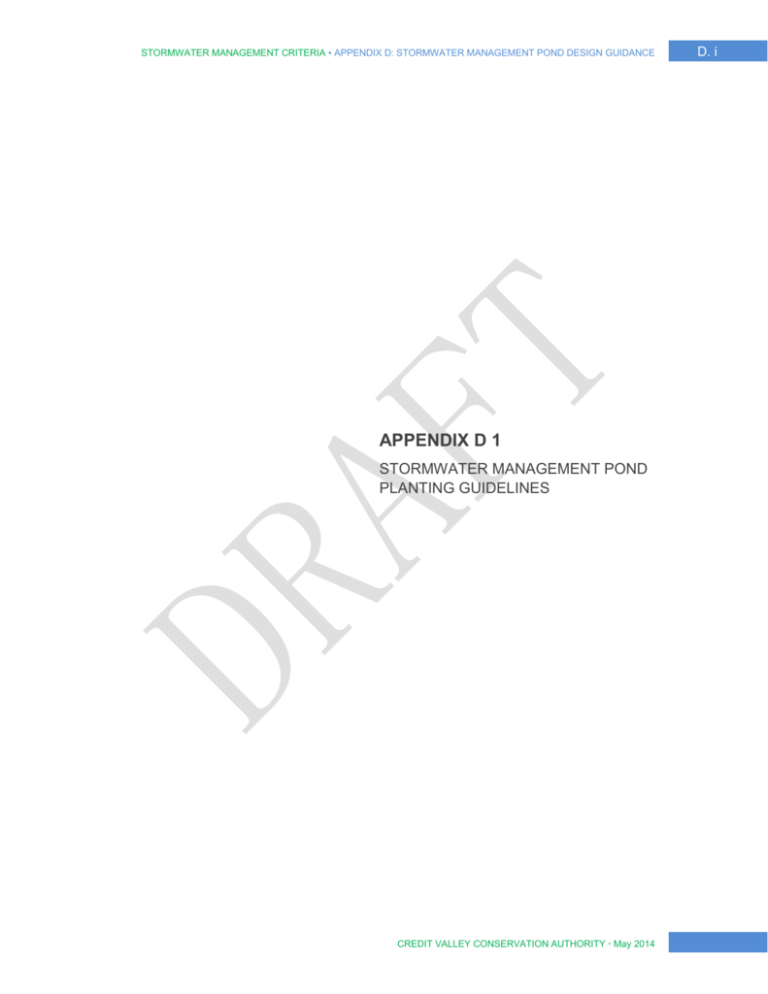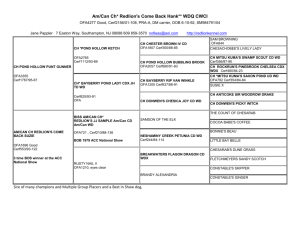Draft CVC stormwater management pond planting guidelines
advertisement

STORMWATER MANAGEMENT CRITERIA ▪ APPENDIX D: STORMWATER MANAGEMENT POND DESIGN GUIDANCE APPENDIX D 1 STORMWATER MANAGEMENT POND PLANTING GUIDELINES CREDIT VALLEY CONSERVATION AUTHORITY May 2014 D. i D. ii STORMWATER MANAGEMENT CRITERIA ▪ APPENDIX D: STORMWATER MANAGEMENT POND DESIGN GUIDANCE CVC would like to thank the staff of the following organizations for their technical input in developing these guidelines: Toronto and Region Conservation Authority Conservation Halton Ministry of Natural Resources City of Brampton Town of Halton Hills Ontario Seed Company The MBTW Group Landscape Architects Strybos Barron King Ltd. Landscape Architecture Alexander Budrevics & Associates Ltd. Landscape Architects NAK Design Strategies Landscape Architects Baker Turner Inc. Landscape Architecture Schollen and Company Inc. Landscape Architecture CREDIT VALLEY CONSERVATION AUTHORITY May 2014 STORMWATER MANAGEMENT CRITERIA ▪ APPENDIX D: STORMWATER MANAGEMENT POND DESIGN GUIDANCE D1. Stormwater Management Pond Planting Guidelines These guidelines were developed to assist landscape architects in preparing planting plans for stormwater management (SWM) quality ponds. The following sections provide guidance on various aspects relevant to SWM landscaping design including the moisture zones present in a typical SWM pond, plant selection, seed mixes, calculations of plant materials, stocking sizes, and topsoil and site preparation. Plantings within SWM quality ponds provide various functions including contributing to water quality, shading of the permanent pool, stabilization of the pond slopes, and minimizing maintenance requirements. Further, the plantings assist with municipal canopy cover targets and, when compatible and complementary, help protect and enhance adjacent natural heritage features and areas. Note however, that despite being compatible, SWM ponds are not considered part of natural heritage systems. In order to expedite the approval process and limit the number of submissions, the landscaping submission should include a cover letter indicating whether the submitted plans conform to CVC guidelines. The letter should also identify what aspects of the plan do not meet the guidelines and provide and explanation. Local municipal staff should be consulted before preparing the planting plan as municipal requirements may vary from these guidelines. Moisture Zones CVC has identified five moisture zones within SWM ponds (Figure D1). These zones are defined by water depth within the pond and storm event levels. The defining contours should be obtained from the engineering plans and included on the landscaping plans. Following is a description of the zones: Zone 1: Water depths between 0.5 m and 2 m within the pond Zone 2: Water depths between the permanent pool level and 0.5 m within the pond Zone 3: Between the permanent pool level and the extended detention level Zone 4: Between the extended detention level and the 5 year storm level Zone 5: All areas above the 5 year storm level within the SWM Block CREDIT VALLEY CONSERVATION AUTHORITY May 2014 D. 1 D. 2 STORMWATER MANAGEMENT CRITERIA ▪ APPENDIX D: STORMWATER MANAGEMENT POND DESIGN GUIDANCE Figure D1: SWM Pond Moisture Zones (N.T.S.) Plant Selection Species that are appropriate for the conditions within each zone should be provided. Following are the plant assemblages that should be provided in each zone: Zone 1: include plugs of submergent and floating species Zone 2: include plugs of at least 4 emergent species Zone 3: include plugs of suitable sedges, rushes, and/or herbaceous species along the fringe of the permanent pool and a seed mix and a minimum of 2 species each of shrubs and trees throughout the zone Zone 4: include a seed mix and a minimum of 4 species each of shrubs and trees Zone 5: include a seed mix and a minimum of 4 species each of shrubs and trees At least two species that spread quickly should be used in Zones 1 and 2. The same shrub and tree species can be used to meet the minimum recommendations for each zone. Successional species and species that are compatible and complementary to adjacent natural areas should be considered in the development of the plan. CREDIT VALLEY CONSERVATION AUTHORITY May 2014 STORMWATER MANAGEMENT CRITERIA ▪ APPENDIX D: STORMWATER MANAGEMENT POND DESIGN GUIDANCE Refer to the CVC Plant Selection Guideline for a list of plants acceptable for use within the Credit River watershed. The CVC Plan Selection Guideline can be found at: http://www.creditvalleyca.ca/planning-permits/policies-guidelines/. The guideline identifies: Recommended SWM pond moisture zones for all plants A selection of plants specifically recommended for use within SWM pond blocks Plants that are emergent, submergent, and floating aquatic species Recommended Species for Seed Mixes To stabilize soils appropriate seed mixes should be specified for all areas above the permanent pool. A Dry SWM pond seed mix and Wet SWM pond seed mix are recommended for application above and below the 5 year storm level respectively. Sod is generally not acceptable within the SWM pond. Cover crops (refer to the CVC Plant Selection Guideline) should be included to establish quick vegetative cover and to stabilize the site. CVC has developed two lists of recommended species for SWM pond seed mixes (Table D1 and Table D2). These lists are comprised of species that appear to be successful within SWM ponds based on a review of SWM ponds within our watershed and the following reports: Performance Assessment of a Highway Stormwater Quality Detention Pond (SWAMP 2003) and Town of Aurora Stormwater Ponds Vegetation & Wildlife Study (Aurora Environmental Advisory Committee 2007). Table D1: CVC Recommended Species for Dry SWM Pond Seed Mixes Scientific Name Common Name Solidago altissima var. altissima Solidago canadensis var. canadensis Rudbeckia hirta Symphyotrichum lanceolatum ssp. lanceolatum Symphyotrichum novae-angliae Anemone canadensis Juncus dudleyi Euthamia graminifolia Late Goldenrod Canada Goldenrod Black-eyed Susan Panicled Aster New England Aster Canada Anemone Dudley’s Rush Grass-leaved Goldenrod CREDIT VALLEY CONSERVATION AUTHORITY May 2014 D. 3 D. 4 STORMWATER MANAGEMENT CRITERIA ▪ APPENDIX D: STORMWATER MANAGEMENT POND DESIGN GUIDANCE Table D2: CVC Recommended Species for Wet SWM Pond Seed Mixes Scientific Name Common Name Eupatorium maculatum ssp. maculatum Verbena hastata Anemone canadensis Symphyotrichum lanceolatum ssp. lanceolatum Symphyotrichum novae-angliae Rudbeckia hirta Carex vulpinoidea Juncus effusus ssp. solutus Juncus torreyi Juncus dudleyi Bidens cernua Bidens frondosa Euthamia graminifolia Spotted Joe-pye Weed Blue Vervain Canada Anemone Panicled Aster New England Aster Black-eyed Susan Fox Sedge Lamp Rush Torrey’s Rush Dudley’s Rush Nodding Bur Marigold Devil's Beggarticks Grass-leaved Goldenrod To match the range of moisture conditions present within each area the lists include facultative species in addition to dry or wet species. It is recommended that the seed mixes specified on the planting plan include a high proportion of the listed species. As other species may be appropriate for your site, any species that meets the CVC Plant Selection Guideline could be added to species above. Calculation of Plant Material The quantity of trees and shrubs needed for the SWM pond block above the permanent pool should be calculated based on 5 m centres (25 m2) and 1 m centres (1 m2) respectively. This spacing is used to calculate total quantities only; the plants can then be specified in nodal groupings to promote natural colonization and spreading. Trees should be planted no closer than 2.5 m on centre and shrubs should be planted 0.75 m – 1.5 m on centre. The formula below allows for flexibility in the respective numbers of trees and shrubs while providing the appropriate amount of overall woody coverage. A = (# trees X 52) + (# shrubs X 12) Where A = full area of the pond block above the permanent water level that is to be planted (i.e. excluding trails, access roads, sediment drying area, etc) in m2 To use the formula choose the desired amount of trees or shrubs and solve for the other. The chosen number of trees or shrubs should be a reasonable amount and ensure that all other aspects of these guidelines are being addressed. CREDIT VALLEY CONSERVATION AUTHORITY May 2014 STORMWATER MANAGEMENT CRITERIA ▪ APPENDIX D: STORMWATER MANAGEMENT POND DESIGN GUIDANCE A sample calculation is provided below: Area of SWM pond block to be planted: 1.0 ha (i.e. 10,000 m2) Chosen number of trees to be planted: 350 10,000 m2 = (350 X 52) + (# shrubs X 12) 10,000 – 8750 = # shrubs 1250 = # shrubs The quantity of aquatic plants should be calculated based on 3 units per linear metre of water’s edge for each of Zones 1 and 2. Additional plantings should be provided in a zone if it is greater than 2 m in width. Aquatic plants should be planted 0.5 m – 1.0 m on centre. In general, plants that spread slowly should be specified on the low side of the range while plants that spread quickly can be specified on the high side of the range. Stocking Sizes Plants of the following stocking sizes are recommended as they generally have established root systems and are less susceptible to herbivory and competition for sunlight from herbaceous species. Recognizing the harsh conditions typically present in SWM pond settings these factors will help decrease the length of time needed for plant establishment and increase planting success. Further, plants of these sizes will provide more immediate shade than smaller stock. To maximize these immediate thermal benefits, it is preferable to locate the larger tree sizes specified on the plan close to the permanent pool. Whips: 1.5 m – 2.5 m in height Caliper: 40 mm – 60 mm Conifers: 1.5 m – 2.0 m in height Shrubs: provide a range between 40 cm – 100 cm in height CREDIT VALLEY CONSERVATION AUTHORITY May 2014 D. 5 D. 6 STORMWATER MANAGEMENT CRITERIA ▪ APPENDIX D: STORMWATER MANAGEMENT POND DESIGN GUIDANCE Review Table In order to help expedite CVC’s review a table summarizing the information outlined above should be provided directly on the planting plans. See the following example: Moisture Zone Area of Zone(m2)/ Length of Water’s Edge(m) Species Quantity of Plants Required Quantity of Plants Provided Scientific Name Common Name Size 1 2 3 4 5 Topsoil and Site Preparation The design engineer and site supervisor should review suitability of subsoil and topsoil material with landscape architect. Considerations include: texture, compaction, pH and organic matter. Confirmation that soil conditions are appropriate for planting should be included with the submitted plans Subsoil should be de-compacted/scarified to ensure proper integration between subsoil and topsoil. If required, amendments to the existing subsoil or topsoil should be made as directed by the landscape architect. The ultimate soil conditions should be reflective of the type of vegetation that is to be established. There are two recommended options for the provision of topsoil above the permanent pool level within a SWM pond block: • Option 1: Provide 0.45 m to 1.0 m of topsoil spread evenly throughout the entire area in a continuous layer • Option 2: Provide a minimum 0.15 m depth of topsoil spread evenly throughout the entire area in a continuous layer and, in areas were trees CREDIT VALLEY CONSERVATION AUTHORITY May 2014 STORMWATER MANAGEMENT CRITERIA ▪ APPENDIX D: STORMWATER MANAGEMENT POND DESIGN GUIDANCE and shrubs are being planted, raised or excavated beds with a minimum topsoil depth of 1.0 m and 0.45 m respectively. Provide 0.30 m of topsoil for the first two metres in depth below the permanent pool level (i.e. in Zones 1 and 2). Stabilize topsoil within the construction year’s growing season. If this cannot be achieved then topsoil should not be spread until the following spring and an interim stabilization measure should be used to prevent erosion of graded substrate (e.g. erosion matting). Stabilize topsoil prior to planting woody material using an acceptable seed mix. The site should be protected from further compaction during site preparation. More details on soil management and site preparation considerations can be found in the document Preserving and Restoring Healthy Soil: Best Practices for Urban Construction Version 1.0 (Toronto and Region Conservation, June 2012). Although this is not specific to stormwater management facilities the information can be adapted for landscaping practices in these features. Design Considerations If a forebay is part of the pond design it is recommended that this area only be planted with Broad-leaf Cattail (Typha latifolia), as other submergent, emergent and aquatic species may be less apt to re-colonize after sediment dredging operations. If sediment drying areas are present they should be seeded with the appropriate mix(es). Further, the SWM pond maintenance plan should indicate that a native seed mix(es) acceptable to CVC should be utilized to rehabilitate the area after sediment drying has taken place. In order to minimize thermal impacts to downstream fisheries a high density of trees and shrubs should be used in proximity to the permanent pool level, especially on the south and west aspects of the pond. Increase density of compatible vegetation along the portion of the SWM Pond Block adjacent to natural areas. Utilize dense shrubby vegetation close to the permanent pool to discourage loafing geese. Note that protection of planting nodes may still be required. The restoration/enhancement of disturbed areas associated with the construction of the pond outfall(s) should be included on the plan. Acceptable seed mix(es) should be used to stabilize soils and woody vegetation should be used to shade the flow path and to minimize rilling and gullying. Discussions between the design engineer and landscape architect should occur early in the planning process before pond blocks are determined. This will ensure that the pond design establishes the conditions that will ensure the successful establishment and survival of vegetation and address ecological concerns. Considerations include: pond orientation, site preparation, and the topsoil depth relative to pond liners and pond storage volumes. Information on pond orientation can be reviewed in section 3.3.1.3 of CREDIT VALLEY CONSERVATION AUTHORITY May 2014 D. 7 D. 8 STORMWATER MANAGEMENT CRITERIA ▪ APPENDIX D: STORMWATER MANAGEMENT POND DESIGN GUIDANCE CVC’s document: Thermal Impacts of Urbanization including Preventative and Mitigation Techniques (CVC, January 2011). CREDIT VALLEY CONSERVATION AUTHORITY May 2014








